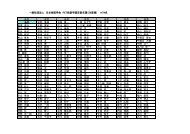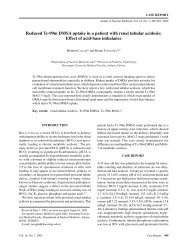Radiopharmaceutical management of 90Y/111In labeled antibodies ...
Radiopharmaceutical management of 90Y/111In labeled antibodies ...
Radiopharmaceutical management of 90Y/111In labeled antibodies ...
You also want an ePaper? Increase the reach of your titles
YUMPU automatically turns print PDFs into web optimized ePapers that Google loves.
Table 1 Effect <strong>of</strong> shielding against <strong>90Y</strong> radiation<br />
Radiation level<br />
(%)<br />
Unprotected <strong>90Y</strong> vial 100<br />
Laminar flow cabinet underneath 0.3<br />
Cabinet plus 2 cm perspex in front window 3<br />
Brass heating pig 3 mm 35<br />
Perspex shield 10 mm 35<br />
Perspex shield 10 mm with 3 mm leaden shield 9<br />
Perspex flask container 16 mm 23<br />
Perspex flask container with 3 mm leaden shield 5<br />
Levels <strong>of</strong> residual radiation are expressed as a percentage <strong>of</strong> the<br />
radiation level <strong>of</strong> the unprotected source vial containing 1830<br />
MBq <strong>90Y</strong>. For each shielding situation, the distance between<br />
radiation source and measuring monitor has been kept to a<br />
minimum. Build-up effects were not taken into account.<br />
Fig. 2 Temperature monitoring during preparation and radiochemical<br />
purity control <strong>of</strong> 90 Y-carrying proteins. Logged data <strong>of</strong><br />
the temperature course (A) can be archived together with the<br />
main data files. The labeling percentage <strong>of</strong> this preparation is<br />
91% (B).<br />
as close as physically possible, reflecting the radiation to<br />
which body parts would be maximally exposed. For<br />
instance, the distance between the unprotected vial and<br />
monitor (the 100% level <strong>of</strong> radiation) was zero, but this<br />
distance was about 50 cm when the vial was placed on the<br />
floor <strong>of</strong> the laminar flow cabinet and the monitor held<br />
underneath the cabinet (0.3% level <strong>of</strong> radiation). Brass<br />
with a thickness <strong>of</strong> 3 mm showed a shielding capacity<br />
equal to 10 mm <strong>of</strong> Perspex and an extra lead shield is<br />
therefore recommended. The same holds for the Perspex<br />
flask container (thickness 16 mm). No effort was undertaken<br />
to identify the physical character <strong>of</strong> the radiation. It<br />
is anticipated, that the majority represents bremsstrahlung<br />
perhaps with the exception <strong>of</strong> the unprotected vial. The<br />
90 Y-specific shielding measures can easily be removed<br />
for other daily purposes.<br />
578 Formijn J. van Hemert, Gerrit W. Slo<strong>of</strong>, Kirsten J.M. Schimmel, et al<br />
Fig. 3 Calibration curves <strong>of</strong> identical amounts <strong>of</strong> 90 Y in thinwall<br />
(squares) and thick-wall (diamonds) glass vials, and in 10<br />
ml syringes (triangles) for increasing volumes. Note: the dip in<br />
the diamond curve at 6 ml is an artifact.<br />
Fig. 4 Quench curve for 90 Y Cerenkov scintillation counting.<br />
A window <strong>of</strong> 0–50 keV was set for unquenched samples.<br />
Counting efficiency (%cpm/dpm) is plotted against the proportion<br />
<strong>of</strong> quenching agent. The highest point <strong>of</strong> quenching corresponds<br />
to serum with approximately 10% hemolysis (see text).<br />
Calibration, preparation and quantification<br />
Isotope-specific calibration factors <strong>of</strong> dose calibrators<br />
were adapted until the read-out equaled the amount <strong>of</strong><br />
MBq in a certified 90 Y or 111 In standard. This was performed<br />
for each type <strong>of</strong> container (vial or syringe) and<br />
every volume to be applied, separately. On this basis, 90 Yand<br />
111 In-<strong>labeled</strong> immunoconjugate doses were prepared<br />
and controlled for their radiochemical purity (Fig. 2).<br />
After appropriate calibration, the doses were diluted to<br />
100 ml for infusion into patients (see below).<br />
As an alternative to the adaptation <strong>of</strong> isotope-specific<br />
calibration factors, correction for the volume dependence<br />
<strong>of</strong> 90 Y in a γ-dose calibrator can also be achieved by<br />
constructing volumetric calibration curves. The results<br />
for two different vials containing initially identical amounts<br />
<strong>of</strong> 90 Y (Fig. 3) show that the thickness and the quality (lead<br />
content) <strong>of</strong> the vial’s glass, in addition to the solution’s<br />
Annals <strong>of</strong> Nuclear Medicine







